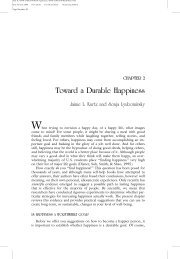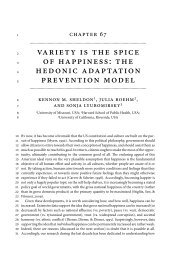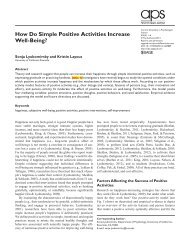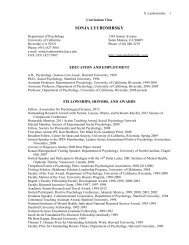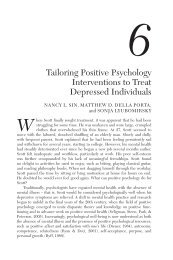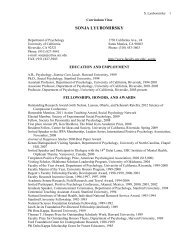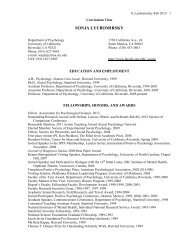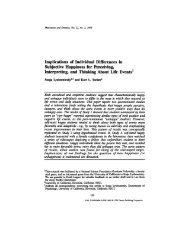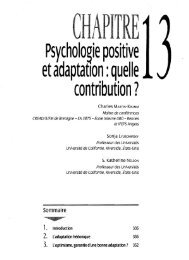Maximizing Versus Satisficing: Happiness Is a Matter of Choice
Maximizing Versus Satisficing: Happiness Is a Matter of Choice
Maximizing Versus Satisficing: Happiness Is a Matter of Choice
You also want an ePaper? Increase the reach of your titles
YUMPU automatically turns print PDFs into web optimized ePapers that Google loves.
MAXIMIZING VS. SATISFICING AND WELL-BEING<br />
1191<br />
the laboratory, the question remains how maximizers and satisficers<br />
respond to social comparison feedback during the course <strong>of</strong><br />
decisions in their everyday life.<br />
Taken together, our findings in Studies 2 and 3 provide support<br />
for the notion that maximizers are more likely than satisficers to<br />
seek out and respond to social comparison information each time<br />
they try to make the “perfect choice.”<br />
Study 4. <strong>Maximizing</strong>, <strong>Satisficing</strong>, and Regret<br />
The first three studies have provided evidence <strong>of</strong> individual<br />
differences in the disposition to maximize that correlate with other<br />
important variables and are reflected in self-reports about purchasing<br />
decisions. Further, there is evidence, both from self-report and<br />
experimental data, that maximizers are more inclined to engage in<br />
social comparisons and to be more sensitive to their contents than<br />
are satisficers. The final study reported here tested whether a<br />
disposition to maximize relates to actual decision-making behavior.<br />
We created a game that required participants to make decisions,<br />
and investigated whether maximizers made different decisions,<br />
and experienced different degrees <strong>of</strong> satisfaction from those<br />
decisions, than did satisficers.<br />
The second aim <strong>of</strong> Study 4 was to explore experimentally the<br />
relation between maximizing and regret. We reported in Study 1<br />
consistent and substantial correlations between scores on our Maximization<br />
Scale and scores on our Regret Scale. We also reported<br />
evidence that partially supported the hypothesis that regret mediates<br />
the relations between maximization and various measures <strong>of</strong><br />
well-being. On the basis <strong>of</strong> this evidence, we suggested that one <strong>of</strong><br />
the factors that may lead maximizers to experience less happiness<br />
and satisfaction with life than satisficers is maximizers’ increased<br />
sensitivity to regret—both experienced and anticipated. If that is<br />
true, then it should be the case that experimental manipulations<br />
designed to enhance the possibility <strong>of</strong> experiencing regret should<br />
have a larger impact on maximizers. The game used in Study 4 was<br />
designed to manipulate the potential to experience regret.<br />
We used a variant <strong>of</strong> the ultimatum game (Camerer & Thaler,<br />
1995; Guth, Schmittberger, & Schwarze, 1982). In the ultimatum<br />
game, one player has control <strong>of</strong> a resource (typically a sum <strong>of</strong><br />
money) and <strong>of</strong>fers some part <strong>of</strong> that resource to another player.<br />
That player may either accept the <strong>of</strong>fer, in which case the resource<br />
is divided in keeping with the <strong>of</strong>fer, or reject it, in which case<br />
neither player gets anything. This game has been <strong>of</strong> interest to<br />
experimental economists because an analysis <strong>of</strong> optimal strategy<br />
by a rational maximizer <strong>of</strong> gain would seem to dictate that the<br />
proposer make the smallest legal <strong>of</strong>fer, secure in the knowledge<br />
that the recipient <strong>of</strong> that <strong>of</strong>fer will accept it (a little <strong>of</strong> something<br />
is better than nothing). This pattern is virtually never observed<br />
among actual participants. First, recipients <strong>of</strong> <strong>of</strong>fers routinely<br />
reject them if they are too low (e.g., less than 30% <strong>of</strong> the resource).<br />
Second, proposers rarely make such low <strong>of</strong>fers.<br />
With respect to regret, there is an interesting asymmetry to the<br />
ultimatum game. The proposer will always know if he or she has<br />
made an <strong>of</strong>fer that is too low, because the recipient <strong>of</strong> that <strong>of</strong>fer<br />
will have rejected it. However, the proposer will not know if the<br />
<strong>of</strong>fer was too high because there is no information about the<br />
minimum acceptable <strong>of</strong>fer—the reservation price. When the recipient<br />
accepts the <strong>of</strong>fer, it could be that the <strong>of</strong>fer was at exactly the<br />
price necessary for acceptance or that it was higher than necessary.<br />
Thus, one would expect proposers who are worried about regretting<br />
their decisions to make unnecessarily high <strong>of</strong>fers. That way,<br />
they will avoid the only source <strong>of</strong> regret that the situation permits—an<br />
<strong>of</strong>fer that is rejected. Suppose, however, that the game<br />
were altered so that proposers would be told what the minimum<br />
acceptable <strong>of</strong>fer was on trials <strong>of</strong> the game in which their <strong>of</strong>fers<br />
were accepted. Thus, they might <strong>of</strong>fer $5 <strong>of</strong> a $10 stake, have their<br />
<strong>of</strong>fer accepted, and then find out that an <strong>of</strong>fer <strong>of</strong> $3 also would<br />
have been accepted. Under these conditions, it is possible to regret<br />
<strong>of</strong>fers that are too high just as it is possible to regret <strong>of</strong>fers that are<br />
too low. Zeelenberg and Beattie (1997) found that <strong>of</strong>fers in this<br />
modified ultimatum game tended to be lower than <strong>of</strong>fers under the<br />
standard procedure. Our question, based on the hypothesis that<br />
maximizers are more sensitive to regret than satisficers, was<br />
whether the effect observed by Zeelenberg and Beattie would be<br />
larger for maximizers than for satisficers.<br />
Participants<br />
Method<br />
The participants were 84 students (48 female and 36 male) enrolled in an<br />
introductory psychology course at Swarthmore College who received<br />
course credit.<br />
Procedure<br />
All participants had previously completed a packet <strong>of</strong> questionnaire<br />
materials including the Maximization Scale and the Regret Scale. Approximately<br />
7 weeks later, participants were directed to a Web site for participation<br />
in another study. They were given 2 weeks in which to do the tasks<br />
on the Web site at a time and place that was convenient to them. About<br />
75% <strong>of</strong> the participants completed the tasks within the allotted time. The<br />
others were sent follow-up reminders by e-mail until all but 7 had complied.<br />
No mention was made <strong>of</strong> the connection between this study and the<br />
questionnaire materials they had completed earlier.<br />
Each participant played two versions <strong>of</strong> the ultimatum game, in counterbalanced<br />
order: a “standard” version and a modified version (they<br />
differed in only one respect, described below). Each version included 10<br />
rounds. In the standard version, participants first encountered a screen that<br />
told them that they were “Player 1,” that the computer would be “Player 2,”<br />
and that the computer would be making decisions based on the performance<br />
<strong>of</strong> real people playing the identical game. Participants were also told<br />
that on each round, they would be given a sum <strong>of</strong> money (between $8 and<br />
$15). They were to make a whole dollar <strong>of</strong>fer to Player 2 (the computer),<br />
who would know what amount <strong>of</strong> money was being divided on each round,<br />
and could accept or reject the <strong>of</strong>fer. Participants were further informed that<br />
the computer would simulate Player 2’s responses on the basis <strong>of</strong> past<br />
behavior <strong>of</strong> people who have played this game. Moreover, it was explained,<br />
on each round, a different past player would be used for the simulation, so<br />
participants were to treat each round as playing with a different Player 2.<br />
For each round, if the participant’s <strong>of</strong>fer was accepted, Player 2 (the<br />
computer) would “get” the amount <strong>of</strong>fered, while Player 1 (the participant)<br />
would get the difference between the total amount and the amount <strong>of</strong>fered.<br />
Thus, for example, if a round started with $12 available, and Player 1 made<br />
an <strong>of</strong>fer <strong>of</strong> $5 that was accepted, Player 2 would get the $5, and Player 1<br />
would get $7. If the <strong>of</strong>fer was rejected, neither player would get anything.<br />
Participants were also told that there was a chance that they would actually<br />
get to keep whatever amount resulted from a given round <strong>of</strong> the game. At<br />
the end <strong>of</strong> each round, participants were asked to click the mouse along an<br />
unmarked line that was anchored on the left with very unsatisfied and on<br />
the right with very satisfied to indicate their satisfaction with that round <strong>of</strong><br />
the game.



